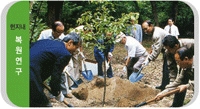- 글로벌메뉴
- KOREAN

 Korea Biodiversity Information System > Plant Resource > Plant Classification > Protected Plants > Preservation Efforts
Korea Biodiversity Information System > Plant Resource > Plant Classification > Protected Plants > Preservation Efforts
Research on natural habitats by species is the most fundamental and essential data for preserving plants. In order to obtain an accurate plant list, accurate information is required about plant populations in their native habitats, as well as their taxonomic and geographic characteristics, even in deciding the priority plants to be preserved, rather than following the intuition of some experts. In Korea, there is little scientific information about the distribution status and characteristics of most plants except for some important tree species. This researched plant information is used as a basis for establishing conservation strategies and leads to in-situ/ex-situ conservation.

The most aggressive practice for plant preservation is restoration. Recently in Korea, interest in the conservation of specific species and habitats of wild plants and animals has increased, and practical restoration projects for some species have been executed. But most of these focused on the action itself, and a systematic restoration that understood the movements of plants and analyzed their genetic characteristics has not been accomplished yet.
| Restoration year | Plant name | Restoration site | Restoration year | Plant name | Restoration site |
|---|---|---|---|---|---|
| 1990 | Berchemia racemosa | Jeonbuk Gunsan | 2000 | Malus asiatica | Seoul Pyeongchangdong |
| 1991 | Forsythia saxatilis | Seoul bughansan | 2000 | Viola seoulensis Nakai | Seoul Namsan |
| Stephanandra incisa | Seoul Suraksan | 2006 | Bupleurum latissimum | Ulleungdo | |
| 1992 | Cotoneaster wilsonii | Ulleungdo Dodong | 2006 | Scrophularia takesimensis | Ulleungdo |
| 1993 | Chloranthus glaber | Jejudo Seogwipo | 2008 | Bupleurum latissimum | Ulleungdo |
| 1994 | Paliurus ramosissimus | Jejudo Namwoleup | 2008 | Caragana koreana | Gangwondon Jeongseongun |
| 1995 | Metanarthecium luteo-viride | Suwon Chilbosan | 2008 | Prunus choreiana Nakai | Gangwondo Jeongseongun |
| 1995 | Acanthopanax seoulense | Seoul Suraksan | 2008 | Forsythia saxatilis | Gangwondo Jeongseongun |
| 1995 | Jeffersonia dubia | Seoul Yongmasan | 2009 | Cypripedium japonicum | Gyeonggido Pocheonsi |
| 1995 | Osmanthus insularis | Jejudo Jeolbuam | 2010 | Anemone flaccida | Jeonbuk Sunchanggun |
| 1996 | Pyrus ussuriensis var.seoulensis | Achasan | 2010 | Habenaria radiate | Gyeunggido Suwonsi |
| total 21 species | |||||

Ex-situ conservation literally means "off-site conservation." Although it is an ideal way to conserve all plants in their native habitats, it is possible that the case of ex-situ conservation of native habitats is difficult for various reasons, such as development and competition or an unexpected, urgent situation, and arboretums and botanical gardens may become the most effect institutes to conserve germplasms.